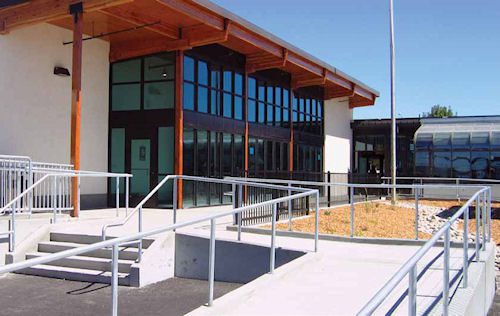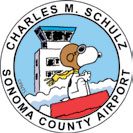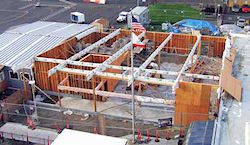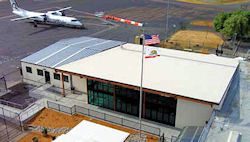
 If Snoopy were at the September open house for the $2.5 million remodel of Charles M. Schulz – Sonoma County (California) Airport, he would have probably done his happy dance.
If Snoopy were at the September open house for the $2.5 million remodel of Charles M. Schulz – Sonoma County (California) Airport, he would have probably done his happy dance.
Truth be told, Snoopy is always at the airport. It is, after all, named after the artist who created the cartoon beagle and the rest of the Peanuts gang. Snoopy is found in artwork and even on the airport logo, which shows him as the Flying Ace, piloting his red doghouse. His pal World Traveler Lucy appears on a painted statue inside the terminal, and bronze Charlie Brown and Linus figures lean on a brick wall outside, as if pondering life – or maybe the life of the airport.
The airport, which dates back to 1941, added Charles M. Schulz to its name in 2000 to honor the comic strip artist who lived for many years in Sonoma County.
|
Facts & Figures Project: Terminal Remodel & Expansion Location: Charles M. Schulz – Sonoma County (CA) Airport Approximate Cost: $2.56 million Benefits: Almost 5,000 additional sq. ft. of space; 30% larger public & passenger areas; updated design Project Management: Sonoma County Architect: Mead & Hunt General Contractor: Murray Building Baggage Carousel: G&S Airport Conveyor Opening Glass Wall: NanaWall Systems TV Network & MUFIDS: ProDIGIQ Traffic Safety Technology: LightGuard Systems |
The recently completed remodel provides almost 5,000 additional square feet and expands public and passenger areas by about 30% to almost 15,000 square feet. The original terminal building was built in 1967.
Good Grief
Before renovations, the airport’s terminal was about 7,500 square feet. A separate triple-wide modular facility housed passenger screening and provided a secure holding area. “The remodel connects the two so they feel like one building,” explains Stout.
Passenger screening was moved to a new, larger space that allows for a privacy area. The hold room, still in the modular, now has an additional 450 square feet, for a total of about 2,160 square feet.
Space inside the old terminal was a problem, says Stout. With a restaurant and back-office support area occupying most of the space, the lobby was only about 1,500 square feet. “It was pretty cramped,” he recalls.
Queuing for the security checkpoint was outside, on the patio, where passengers encountered cold and heat. If winds were strong enough to blow under the overhead metal deck, they were sometimes exposed to rain as well. Queuing now occurs indoors.
Once inside, passengers previously faced a congested lobby area with two check-in counters and three rental car counters. Additional space gained during the remodel allowed the airport to move the three rental car counters out of the lobby and add a fourth. A third ticket counter and four additional ticketing kiosks were also added. The waiting area for screened passengers doubled to about 900 square feet.
Arriving passengers now retrieve their bags inside, from a new baggage carousel, rather than waiting for baggage outside. The oval-shaped carousel, by G&S Airport Conveyor, is about 15 feet long. Half is inside; half is outside.
 A new 600-square-foot baggage processing room (about 250 square feet larger than before) allowed TSA to upgrade to a Reveal CT-80 explosives detection system.
A new 600-square-foot baggage processing room (about 250 square feet larger than before) allowed TSA to upgrade to a Reveal CT-80 explosives detection system.
The remodel also increased the size of the airport’s restrooms. The new facilities have four stalls for women, and two stalls and two urinals for men. Updates inside the restrooms include touchless faucets, ultra-low flow fixtures and ultra-low flow urinals.
On the energy efficiency front, the improved terminal meets California Title 24 requirements, notes Stout. A white roof and more programmable interior lighting were key changes.
Finishing touches for the project included new doors in the original lobby, new carpet throughout the expanded lobby, new fencing and a revolving entry gate between the arrival area and terminal, paved pathways and new landscaping.
Outside In
While no changes were made to the terminal’s front exterior, the interior scheme was redesigned to “match our destination a little better,” says Stout.
The new open design, conceived by Mead & Hunt, features exposed, heavy timber wood – typical architecture for “America’s premier wine, spa and coastal destination,” as Sonoma County is known.
 Scott Long, senior architect and project manager with Mead & Hunt, cites an “operable wall” on the south side of the new addition as one of the terminal’s unique design features. Three bays, about 10 feet by 12 feet, fold back to open the waiting area to the outside patio and create an indoor/outdoor space. A glass wall from NanaWall Systems was placed in the non-secure area near the baggage claim and security checkpoint queuing area.
Scott Long, senior architect and project manager with Mead & Hunt, cites an “operable wall” on the south side of the new addition as one of the terminal’s unique design features. Three bays, about 10 feet by 12 feet, fold back to open the waiting area to the outside patio and create an indoor/outdoor space. A glass wall from NanaWall Systems was placed in the non-secure area near the baggage claim and security checkpoint queuing area.
“The nature of many structures in California reflects the indoor/outdoor quality of the space because you do have the opportunity to use the outdoors a lot more than you would in other places,” explains Long. “You see the hills, the openness of everything, the lightness all built into the facility. It’s airy. It’s bright – just like the world around it.”
Numerous windows on the south side exemplify the feel Long describes.
Tying Old to New
For the first time, visitors say that the terminal feels like a real airport. “We think that’s a tremendous improvement,” notes Stout.
Project manager Wayne Hovey, associate architect for the County of Sonoma Architecture Division, describes the former building as cramped and dark – and easily mistaken for a bus depot.

Recent remodeling expanded public and passenger areas by about 30%.
“It’s definitely a much-improved first impression for people arriving in Sonoma County,” Hovey comments. “To wait for a plane, you had to go outside on the patio regardless of the weather. The remodel is an amazing improvement.”
The newly defined screening area and well-organized ticket counters are noteworthy improvements in Hovey’s book.
 Long says the biggest challenge of designing the remodel was tying the airport’s two existing structures together. Three-dimensional massing helped accommodate different floor and roof heights, he notes.
Long says the biggest challenge of designing the remodel was tying the airport’s two existing structures together. Three-dimensional massing helped accommodate different floor and roof heights, he notes.
Scott Murray, owner of general contractor Murray Building, also prevailed over logistic challenges associated with tying the new to the old.
“We faced some deterioration because of the age and weathering of the building,” Murray says. “We had some structural repairs that you wouldn’t normally have had. The building itself was rather disintegrated because of its age.”
A very wet 2009-2010 winter provided additional hurdles for the general contractor to clear.
Working in and around the airport was a significant challenge for everyone, says Hovey, because the airport and adjacent restaurant had to keep functioning.
 “Flight times were never interrupted,” Hovey reports. “When there was a flight, we would have to pull all the contractors out of the area so that the security screening could occur, and people could go through the area and board the plane; then (crews) could continue to work.”
“Flight times were never interrupted,” Hovey reports. “When there was a flight, we would have to pull all the contractors out of the area so that the security screening could occur, and people could go through the area and board the plane; then (crews) could continue to work.”
The job required a lot of phasing of parts and pieces, he says. Staff had to be relocated several times so they could do their job and construction could proceed.
Money Matters
From a budget standpoint, Stout says the project was very challenging.
In July 2009, Charles M. Schulz-Sonoma County Airport received $1.685 million in American Recovery and Reinvestment Act funds to remodel and expand the passenger terminal. The total budget for the project at that time was $1.757 million. The airport will cover the difference with Passenger Facility Charge funds.
 In hindsight, Stout acknowledges that the budget suffered because plans were rushed to get the project shovel-ready, a primary stimulus fund criterion. In December, the project was running at $2.56 million.
In hindsight, Stout acknowledges that the budget suffered because plans were rushed to get the project shovel-ready, a primary stimulus fund criterion. In December, the project was running at $2.56 million.
“When you start digging for your foundations, and you find utilities that weren’t on any plans, that causes a problem,” he explains. “Knocking down a wall and finding that all the beams are rotten also causes a problem. There were a lot of unforeseen conditions.”
Integrating Info
Changes were also made to create a better customer experience, adds Stout.
The airport is in the process of adding six televisions with the Airport TV Network and a Multi-User Flight Information Display System (MUFIDS) from ProDIGIQ. The Airport TV Network will show passengers their flight status and content pertaining to their destination, along with news, sports and business headlines on high-definition widescreen televisions. Airport officials hope to wrap up the project in the first quarter of 2011.
 |  |
Staff in the air traffic control tower had a good view of the terminal improvements in progress.
ProDIGIQ’s technology initially drew Stout’s attention because he’s a believer in common-use systems. Rather than having to deal with multiple flight information displays for each airline when another carrier comes in, Stout says, “We thought it would be best to have a system that we managed and then partner with the airlines to incorporate their information.”
Stout also likes the idea of having an additional revenue source. ProDIGIQ shares proceeds with the airport from the commercials that run during Airport TV Network programming. Commercials from Sonoma County businesses will run on a television displaying baggage information. A winery, for example, might run a 25-second promotional video to attract business from arriving tourists.
In addition to having a television in the baggage claim area, sets also will be set up near check-in counters. Another television before the security checkpoint will broadcast TSA how-tos.
In the hold room, travelers will be able to watch ads about places they can go when they arrive at their destination city. If someone is heading to Seattle, they can watch programming relevant to Seattle in addition to national and international news. Two hours later, passengers awaiting a flight to Las Vegas will be shown content regarding travel to Las Vegas.
Arpit Malaviya, ProDIGIQ’s vice president of business development, says ProDIGIQ is the first and only company using demographic, psychographic and geographic analysis to bring the most relevant content to airport passengers.
“Monday morning flights predominately have business travelers, so that’s the time we focus more on business news, how the stock market is doing and so forth,” Malaviya cites as an example.
“Passengers typically complain when polarizing news networks such as MSNBC or FOX are shown at airports,” he adds. “ProDIGIQ’s TV Network helps avoid passenger complaints by showing non-polarizing content from a wide variety of sources.”
Some airports have boosted their concession sales by marketing in-airport food options on Airport TV Network, reports Malaviya. Other airport information including flight announcements or construction updates can also be displayed on the MUFIDS and Airport TV Network.
ProDIGIQ’s MUFIDS and Airport TV Network can even encompass social media. With the integrated system, the airport can send a one-way Facebook or Twitter update to airport televisions – a product that previously did not exist in the industry, Malaviya notes.
For an airport of about 100,000 annual enplanements, Stout says Sonoma County does a reasonable amount of marketing. The airport’s promotions range from billboard space downtown to Mylar signs at the airport. Ads appear both online and in business journals. Stout is also working with ProDIGIQ to add an app for iPhones and Droids.
“The Airport TV Network is just another component to our in-terminal advertising,” Stout relates.
The airport uses an information booth inside the terminal to get word out about things going on in Sonoma County. As yet another nod to the airport’s namesake, the info center is fashioned to look like Lucy’s psychiatric booth. Travelers can also learn about airport improvement projects at the booth, including a runway extension expected to be complete in 2013 and longer-term plans for a new terminal.
Sounds like Snoopy may have more dancing to do.
Passenger Safety Ahead
Before “traffic-calming” devices were put in place, Charles M. Schulz-Sonoma County Airport had problems with motorists “flying by” the airport terminal.
 Because the airport is located at the end of a main thoroughfare in a busy industrial area, drivers often passed where they needed to go and would take a 90-degree turn and drive past the terminal. Trying to make up for lost time, motorists were going much faster than the posted 15 mph speed limit.
Because the airport is located at the end of a main thoroughfare in a busy industrial area, drivers often passed where they needed to go and would take a 90-degree turn and drive past the terminal. Trying to make up for lost time, motorists were going much faster than the posted 15 mph speed limit.
Michael Harrison, president/CEO and founder of LightGuard Systems, had a solution: Before the 90-degree turn, an ActiveWarning(tm) sign from LightGuard now lets drivers know there’s a sharp turn ahead. The sign has a radar system that can determine if approaching vehicles are going more than 30 mph. If they are, flashing LED lights are activated along with two smaller chevron signs that remind motorists to obey the posted speed limit.
|
A new traffic control system automatically activates LED warning lights as pedestrians enter the crosswalk and turns them off as they leave. |
Harrison, a former corporate pilot, applies the concept of runway lights to roadways. LightGuard’s Smart Crosswalk(tm) system lights are oriented toward the approaching motorist, away and outward from the crosswalk. The lights are visible to motorists but not pedestrians, he explains.
Airport manager Jon Stout reports that the Smart Crosswalk has slowed down vehicles and encouraged drivers to pay attention to pedestrians crossing the street.
|
The sign’s LED border flashes when the radar detects an approaching vehicle and sits idle until another one is detected. |
“When pedestrians are at the airport, they’re usually carrying bags or dragging their luggage with them; so they don’t want to have to push a button to activate the system,” Harrison comments. “The system is triggered as a pedestrian enters the crosswalk. When they leave the crosswalk, it ‘times out,’ and the system is not retriggered. It’s only activated when someone enters the crosswalk.”
The Smart Crosswalk system also collects data that helps the airport quantify its pedestrian traffic. But the real benefit, notes Harrison, is that no one crossing the street has been struck by a speeding vehicle.




